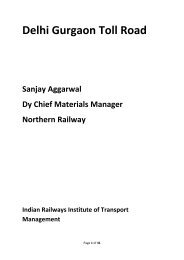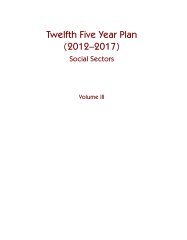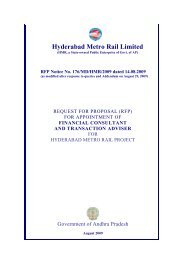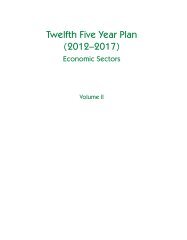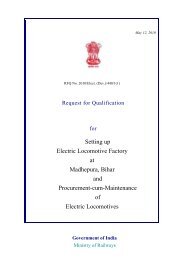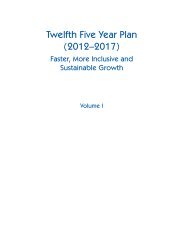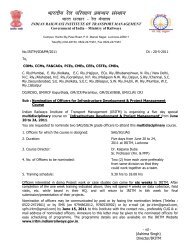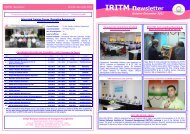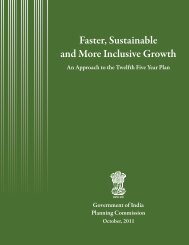Vision 2020 - Transportation Research Group of India
Vision 2020 - Transportation Research Group of India
Vision 2020 - Transportation Research Group of India
You also want an ePaper? Increase the reach of your titles
YUMPU automatically turns print PDFs into web optimized ePapers that Google loves.
CHAPTER-VII<br />
Government <strong>of</strong> <strong>India</strong><br />
Ministry <strong>of</strong> Railways<br />
(Railway Board)<br />
Resource Requirement and Mobilization<br />
A high-growth strategy would require massive investments in capacity creation, network expansion and<br />
upgradation. Annexure-II shows a list <strong>of</strong> capacity enhancement and railway modernization works and a<br />
very rough assessment <strong>of</strong> the investment programme needed to support the achievement <strong>of</strong> the goals <strong>of</strong><br />
the <strong>Vision</strong>. Tentatively, it has been estimated that around Rs. 14,00,000 crore over the next 10 years (i.e.<br />
up to the year <strong>2020</strong>). Of this, most <strong>of</strong> the investment for world-class stations and high speed corridors<br />
could be mobilized through Public-Private Partnerships. A sizeable part <strong>of</strong> the investment required for port<br />
connectivity projects, setting up <strong>of</strong> electric/diesel locomotive manufacturing units and new coach<br />
manufacturing units could also be mobilized through private sector participation by SPV or Joint Venture<br />
(JV) route. Metropolitan Transport Projects and some <strong>of</strong> the new line projects could be taken up with<br />
partnerships with the state governments. Public Private Partnerships could also be used in setting up <strong>of</strong><br />
private freight terminals, logistics parks, wagon investment schemes and licensing <strong>of</strong> freight service<br />
operators who would bring in specialized rolling stock and new terminals. Railways can also borrow within<br />
prudent limits through IRFC.<br />
7.1 Availability <strong>of</strong> internally generated surpluses is expected to go up with 10% annual growth in freight and<br />
passenger traffic. It has been tentatively assessed that Railways would be able to generate about 64% <strong>of</strong><br />
the investment required over the period through internal generation and extra budgetary resources. This<br />
implies that the gap <strong>of</strong> 36% or Rs.5,00,000 Crore would need to be bridged by Gross Budgetary Support<br />
(GBS) from the Central Government. In other words, on an average, budgetary support for the<br />
programme to implement the <strong>Vision</strong> <strong>2020</strong> would need to be at a level <strong>of</strong> around Rs. 50,000 crore per<br />
annum.<br />
Attainment <strong>of</strong> the goals in <strong>Vision</strong> would require a categorical commitment on the part <strong>of</strong> Government to<br />
ear-mark and ensure a steady-flow <strong>of</strong> financial support to the programme. This should be ideally in the<br />
form <strong>of</strong> an Accelerated Railway Development Fund (ARDF) with budgetary commitment to the tune <strong>of</strong><br />
approximately, 5,00,000 crore spread over next 10 years. An amount <strong>of</strong> roughly Rs. 1,00,000 crore <strong>of</strong><br />
the ADRF could be set aside to clear the pending backlog <strong>of</strong> socially desirable New Lines and Gauge<br />
Conversion projects as a one-time outright grant.<br />
7.2 Budgetary disbursement from the ARDF needs to be front-loaded as a high-growth strategy would<br />
necessitate investment in capacity augmentation immediately while the take-<strong>of</strong>f to high-growth and<br />
consequently, generation <strong>of</strong> internal surplus could take at least three years to materialize. During this<br />
period, the impact <strong>of</strong> the implementation <strong>of</strong> 6th Pay Commission would be fully absorbed and preparatory<br />
work to develop and bid out big-scale PPP projects would have been completed to allow a gradual<br />
phasing down <strong>of</strong> the budgetary contribution.<br />
33




